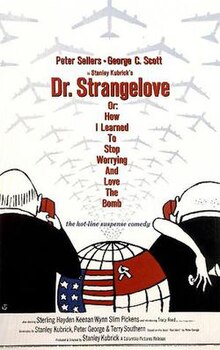
Back Dr. Strangelove or: How I Learned to Stop Worrying and Love the Bomb AN دكتور سترينجلوف Arabic دكتور سترينجلوف ARZ Dr. Strangelove or: How I Learned to Stop Worrying and Love the Bomb AST Doktor Strenclav (film, 1964) Azerbaijani Доктар Стрэйнджлау, або Як я навучыўся не хвалявацца і палюбіў бомбу Byelorussian Д-р Стрейнджлав или как престанах да се страхувам и обикнах атомната бомба Bulgarian ডক্টর স্ট্রেঞ্জলাভ Bengali/Bangla Dr. Strangelove BS Doctor Strangelove Catalan
| Dr. Strangelove or: How I Learned to Stop Worrying and Love the Bomb | |
|---|---|
 Theatrical release poster by Tomi Ungerer | |
| Directed by | Stanley Kubrick |
| Screenplay by |
|
| Based on | Red Alert by Peter George |
| Produced by | Stanley Kubrick |
| Starring | |
| Cinematography | Gilbert Taylor |
| Edited by | Anthony Harvey |
| Music by | Laurie Johnson |
Production company | |
| Distributed by | Columbia Pictures |
Release date |
|
Running time | 94 minutes[1] |
| Countries | |
| Language | English |
| Budget | $1.8 million[6] |
| Box office | $9.2 million (2022)[6] |
Dr. Strangelove or: How I Learned to Stop Worrying and Love the Bomb (known simply and more commonly as Dr. Strangelove) is a 1964 political satire black comedy film cowritten, produced, and directed by Stanley Kubrick and starring Peter Sellers in three roles, including the title character. The film, financed and released by Columbia Pictures, was a co-production between the United States and the United Kingdom.
The film, which satirizes the Cold War fears of a nuclear conflict between the Soviet Union and the United States, also stars George C. Scott, Sterling Hayden, Keenan Wynn, Slim Pickens, and Tracy Reed and is loosely based on the thriller novel Red Alert (1958) by Peter George, who also cowrote the screenplay with Kubrick and Terry Southern.
The story concerns an unhinged United States Air Force general who orders a pre-emptive nuclear attack on the Soviet Union. It separately follows the President of the United States, his advisors, the Joint Chiefs of Staff, and a Royal Air Force exchange officer as they attempt to prevent the crew of a B-52 (following orders from the general) from bombing the Soviet Union and starting a nuclear war.
The film is often considered one of the best comedies ever made and one of the greatest films of all time. In 1998, the American Film Institute ranked it twenty-sixth in its list of the best American movies (in the 2007 edition, the film ranked thirty-ninth), and in 2000, it was listed as number three on its list of the funniest American films. In 1989, the United States Library of Congress included Dr. Strangelove as one of the first 25 films selected for preservation in the National Film Registry for being "culturally, historically, or aesthetically significant".[7][8] The film received four Academy Award nominations, including Best Picture, Best Director, Best Adapted Screenplay, and Best Actor for Sellers. The film was also nominated for seven BAFTA Film Awards, winning Best Film From Any Source, Best British Film, and Best Art Direction (Black and White), and it also won the Hugo Award for Best Dramatic Presentation.
- ^ "Dr. Strangelove". British Board of Film Classification. Archived from the original on November 13, 2014. Retrieved July 6, 2013.
- ^ Pfeiffer, Lee (March 8, 2017). "Dr. Strangelove or: How I Learned to Stop Worrying and Love the Bomb". Encyclopædia Britannica. Archived from the original on December 23, 2020. Retrieved December 3, 2020.
- ^ Kaufman, Dave (January 21, 1964). "Dr. Strangelove or: How I Learned to Stop Worrying and Love the Bomb". Variety. Archived from the original on January 1, 2021. Retrieved December 3, 2020.
- ^ a b "Dr. Strangelove or: How I Learned to Stop Worrying and Love the Bomb". British Film Institute. June 15, 2021. Archived from the original on March 10, 2016.
- ^ a b "Dr. Strangelove or: How I learned to Stop Worrying and Love the Bomb". American Film Institute. June 15, 2021.
- ^ a b "Dr. Strangelove (1964)". m.the-numbers. Retrieved March 23, 2022.
- ^ "ENTERTAINMENT: Film Registry Picks First 25 Movies". Los Angeles Times. Washington, D.C. September 19, 1989. Archived from the original on May 5, 2020. Retrieved April 22, 2020.
- ^ "Complete National Film Registry Listing". Library of Congress. Archived from the original on October 31, 2016. Retrieved June 8, 2020.
© MMXXIII Rich X Search. We shall prevail. All rights reserved. Rich X Search